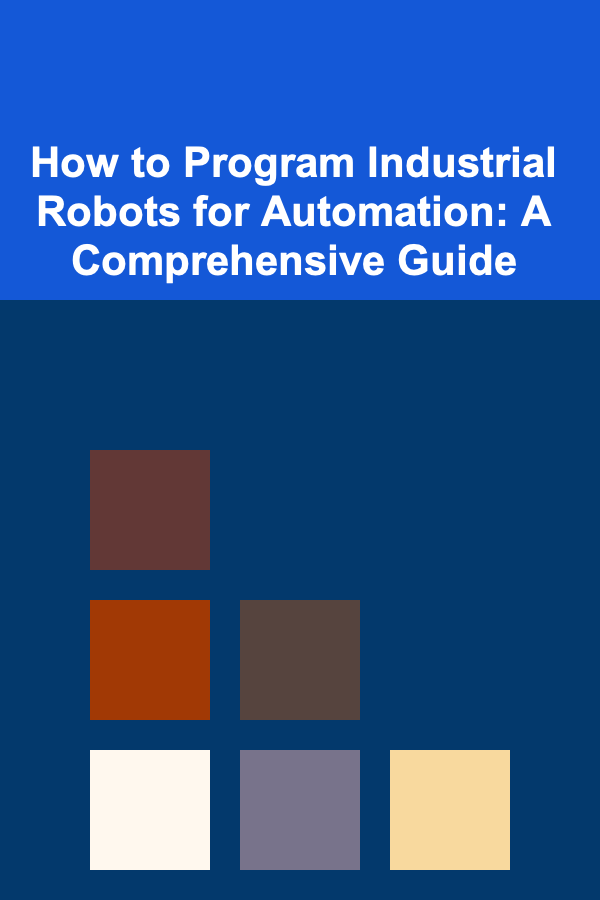
How to Program Industrial Robots for Automation: A Comprehensive Guide
ebook include PDF & Audio bundle (Micro Guide)
$12.99$7.99
Limited Time Offer! Order within the next:

Industrial robots have revolutionized manufacturing and various other industries by providing unparalleled precision, speed, and repeatability. Programming these robots for automation is a complex but rewarding task that requires a thorough understanding of robotics, programming languages, and the specific application at hand. This guide provides an in-depth exploration of the process, covering essential concepts, programming methods, safety considerations, and best practices.
Understanding Industrial Robots
Before diving into programming, it's crucial to understand the fundamental components and characteristics of industrial robots.
Robot Anatomy
An industrial robot typically consists of the following key parts:
- Manipulator (Arm): This is the physical structure of the robot, responsible for performing movements in space. It usually consists of multiple joints and links, allowing for a wide range of motion. Common configurations include articulated (resembling a human arm), SCARA (Selective Compliance Articulated Robot Arm), and Cartesian (linear axes).
- Controller: The brain of the robot. It houses the processors, memory, and software that control the robot's movements and interactions with the environment. The controller interprets the program instructions and translates them into signals that drive the robot's motors.
- End-Effector: The tool attached to the robot's wrist that performs the actual work. This can be a gripper for picking and placing objects, a welding torch, a spray gun, or any other specialized tool.
- Power Supply: Provides the necessary electrical power to operate the robot's motors and controller.
- Teach Pendant: A handheld device used to manually control the robot and teach it specific positions and movements.
Robot Kinematics
Robot kinematics describes the relationship between the robot's joint angles and the position and orientation of its end-effector. Understanding kinematics is essential for programming complex movements and ensuring accurate positioning.
- Forward Kinematics: Calculates the end-effector's position and orientation in space based on the robot's joint angles.
- Inverse Kinematics: Calculates the joint angles required to achieve a desired end-effector position and orientation. This is often a more complex problem, and some positions may have multiple solutions or be unreachable.
Robot Coordinate Systems
Robots use different coordinate systems to define positions and orientations:
- World Coordinate System: A fixed reference frame that defines the robot's overall workspace.
- Tool Coordinate System (TCP - Tool Center Point): A coordinate system attached to the end-effector, defining its position and orientation relative to the tool.
- User Coordinate System: A coordinate system defined by the user to simplify programming in specific areas of the workspace. This is useful when the part being worked on is located at an angle or offset from the world coordinate system.
Programming Methods
Several methods can be used to program industrial robots, each with its own advantages and disadvantages.
Teach Pendant Programming (Online Programming)
This is the most common and traditional method. The programmer uses the teach pendant to manually guide the robot through the desired sequence of movements. Positions are recorded and stored as program points. The robot then executes the program by moving to these recorded points.
Advantages:
- Intuitive and easy to learn for basic tasks.
- Allows for real-time adjustments and fine-tuning of movements.
- No need for specialized programming software or extensive knowledge of robot programming languages.
Disadvantages:
- Can be time-consuming for complex programs.
- Requires the robot to be taken offline during programming, reducing productivity.
- May not be suitable for applications requiring high precision or complex calculations.
Example (Simplified):
MOVE TO POINT_1 (Defined by manually moving the robot to the first point and saving its coordinates)
GRIPPER_OPEN
MOVE TO POINT_2
GRIPPER_CLOSE
MOVE TO POINT_3
END
Offline Programming
Offline programming involves creating and testing robot programs in a virtual environment using specialized software. This allows programmers to simulate the robot's movements, identify potential collisions, and optimize the program before it is deployed on the actual robot.
Advantages:
- Reduces downtime, as programming can be done without taking the robot offline.
- Allows for simulation and collision detection, improving safety and efficiency.
- Enables the creation of complex programs with advanced features.
- Facilitates the optimization of robot trajectories for speed and accuracy.
Disadvantages:
- Requires specialized software and training.
- Can be expensive.
- Accuracy depends on the fidelity of the simulation environment and the calibration of the robot.
Popular Offline Programming Software:
- ABB RobotStudio
- Fanuc ROBOGUIDE
- Siemens Process Simulate
- DELMIA from Dassault Systèmes
Text-Based Programming
Text-based programming involves writing robot programs using a specific robot programming language. These languages provide more flexibility and control than teach pendant programming, allowing for the creation of complex algorithms and customized functions. Each robot manufacturer has its own language (or family of languages). Here are some common ones:
- ABB: RAPID
- Fanuc: Karel
- KUKA: KRL (KUKA Robot Language)
- Yaskawa Motoman: INFORM
Advantages:
- Provides greater flexibility and control over robot movements and functions.
- Allows for the creation of complex algorithms and customized programs.
- Enables integration with other systems, such as PLCs (Programmable Logic Controllers) and databases.
- Suitable for applications requiring high precision and real-time control.
Disadvantages:
- Requires a strong understanding of robot programming languages and robotics concepts.
- Can be more complex and time-consuming than teach pendant programming.
- Requires debugging and testing to ensure program accuracy and reliability.
Example (ABB RAPID - Simplified):
MODULE MainModule
PROC main()
MoveL p1,v1000,z10,tool0; ! Move linearly to point p1 with speed v1000, zone z10, using tool0
WaitTime 1; ! Wait for 1 second
GripIn; ! Close the gripper
MoveL p2,v1000,z10,tool0; ! Move linearly to point p2
GripOut; ! Open the gripper
ENDPROC
VAR speeddata v1000 := [1000,500,5000,500]; ! Define speed data
VAR zonedata z10 := [TRUE,10,10,10,10,10]; ! Define zone data (blending radius)
VAR robtarget p1 := [[500,300,200],[0.707,0,0.707,0],[0,0,0,0],[9E+09,9E+09,9E+09,9E+09,9E+09,9E+09]]; ! Define point p1
VAR robtarget p2 := [[700,300,200],[0.707,0,0.707,0],[0,0,0,0],[9E+09,9E+09,9E+09,9E+09,9E+09,9E+09]]; ! Define point p2
PROC GripIn()
! Code to close the gripper (e.g., set a digital output)
DO dig_output1 := 1;
ENDPROC
PROC GripOut()
! Code to open the gripper (e.g., reset a digital output)
DO dig_output1 := 0;
ENDPROC
ENDMODULE
Robot Operating System (ROS)
ROS is not a traditional operating system, but rather a flexible framework for writing robot software. It provides tools and libraries for robot control, perception, planning, and simulation. While not strictly a programming method, it provides a powerful infrastructure on top of which various programming approaches can be implemented.
Advantages:
- Open-source and widely supported.
- Provides a rich set of tools and libraries for robot development.
- Enables integration with various sensors and actuators.
- Facilitates collaboration and code reuse among developers.
Disadvantages:
- Steeper learning curve compared to other programming methods.
- Can be complex to set up and configure.
- May not be suitable for all industrial robot applications.
Key Programming Concepts
Regardless of the programming method used, several key concepts are essential for successful robot programming.
Path Planning
Path planning involves determining the optimal trajectory for the robot to follow between two points. This includes considering factors such as speed, acceleration, smoothness, and obstacle avoidance.
Types of Motion:
- Joint Interpolation: Moves all joints simultaneously to reach the target position. The trajectory is not necessarily a straight line in Cartesian space.
- Linear Interpolation: Moves the end-effector in a straight line between two points. This is important for applications requiring precise movements.
- Circular Interpolation: Moves the end-effector along a circular path. Requires defining a starting point, an intermediate point, and an endpoint.
Trajectory Generation
Trajectory generation involves creating a detailed plan of the robot's motion over time, specifying the position, velocity, and acceleration of each joint. This is crucial for smooth and accurate movements.
Coordinate Transformations
Coordinate transformations are used to convert positions and orientations between different coordinate systems. This is essential for programming robots to work with objects located in different reference frames.
Sensor Integration
Integrating sensors, such as vision systems, force sensors, and proximity sensors, allows the robot to react to changes in its environment and adapt its behavior accordingly. This is crucial for applications requiring flexibility and adaptability.
Error Handling
Robust error handling is essential for preventing robot failures and ensuring safe operation. The program should include mechanisms for detecting and responding to errors, such as collisions, joint limits, and communication failures.
Programming Steps: A Detailed Workflow
Here's a detailed workflow for programming industrial robots for automation:
- Define the Application: Clearly define the task that the robot will perform. This includes specifying the required movements, accuracy, speed, and payload. Understand the "what" and "why" before addressing the "how."
- Robot Selection: Choose the appropriate robot model for the application. Consider factors such as reach, payload capacity, speed, and accuracy.
- End-Effector Design: Design or select the appropriate end-effector for the task. This could be a gripper, welding torch, spray gun, or other specialized tool.
- Workcell Design: Design the layout of the robot workcell, including the placement of the robot, workpieces, fixtures, and safety devices. Ensure adequate space for the robot to move freely and safely.
- Program Development:
- Choose Programming Method: Select the appropriate programming method based on the complexity of the application and the available resources.
- Define Coordinate Systems: Establish the world, tool, and user coordinate systems.
- Create Program Points: Define the key positions and orientations that the robot will need to reach. This can be done manually using the teach pendant or by importing CAD data into an offline programming environment.
- Write the Program Logic: Write the program code to control the robot's movements, sensor inputs, and actuator outputs. This may involve using a robot programming language or a visual programming environment.
- Simulation and Testing: Simulate the program in a virtual environment to identify potential collisions, optimize the trajectory, and verify the program logic.
- Program Upload and Calibration: Upload the program to the robot controller and calibrate the robot to ensure accurate positioning. This may involve adjusting the robot's joint offsets and the tool center point (TCP).
- On-Robot Testing and Debugging: Test the program on the actual robot and debug any errors or issues. This may involve fine-tuning the robot's movements, adjusting sensor parameters, and modifying the program logic.
- Optimization and Refinement: Optimize the program for speed, accuracy, and reliability. This may involve adjusting the robot's speed and acceleration parameters, refining the trajectory, and implementing error handling routines.
- Documentation: Document the program and the workcell setup. This includes creating a user manual that describes how to operate the robot and troubleshoot common problems.
- Training: Train operators and maintenance personnel on how to operate, maintain, and troubleshoot the robot system.
Safety Considerations
Robot safety is paramount. Programming should always prioritize the safety of personnel and equipment.
Risk Assessment
Conduct a thorough risk assessment of the robot workcell to identify potential hazards. This should include analyzing the robot's movements, the presence of human workers, and the potential for equipment failures.
Safety Devices
Implement safety devices such as:
- Light Curtains: Detect the presence of a person entering the robot's work envelope and stop the robot.
- Emergency Stop Buttons (E-Stops): Immediately stop the robot in case of an emergency.
- Safety Fences: Physically prevent people from entering the robot's work envelope.
- Area Scanners: Monitor the work area for human presence and slow down or stop the robot.
- Two-Hand Control Devices: Require the operator to use both hands to activate the robot, preventing them from being in a hazardous position.
- Software Safety Features: Implement software limits on the robot's movements to prevent it from exceeding its workspace boundaries or colliding with other objects. These limits are often defined in the robot controller's parameters.
Safety Standards
Adhere to relevant safety standards, such as:
- ISO 10218: Safety requirements for industrial robots.
- ANSI/RIA R15.06: American National Standard for Industrial Robots and Robot Systems - Safety Requirements.
Safe Programming Practices
Follow safe programming practices:
- Always test programs in a safe environment before deploying them on the shop floor.
- Use slow speeds and small increments when testing new programs.
- Implement error handling routines to prevent the robot from performing unsafe actions.
- Regularly review and update safety procedures.
Best Practices for Robot Programming
Following these best practices can improve the quality, maintainability, and performance of robot programs.
Modular Programming
Break down complex programs into smaller, reusable modules. This makes the program easier to understand, debug, and maintain.
Descriptive Naming Conventions
Use descriptive names for variables, functions, and program points. This makes the code easier to read and understand.
Comments
Add comments to the code to explain the purpose of each section and the logic behind the program. This is especially important for complex algorithms.
Error Handling
Implement robust error handling routines to detect and respond to errors. This can prevent robot failures and ensure safe operation. Consider using try-catch blocks (or equivalent constructs in the robot's programming language) to handle potential exceptions gracefully.
Optimization
Optimize the program for speed, accuracy, and reliability. This may involve adjusting the robot's speed and acceleration parameters, refining the trajectory, and using efficient algorithms.
Version Control
Use a version control system, such as Git, to track changes to the program and facilitate collaboration among developers. This allows you to easily revert to previous versions of the code if necessary.
Code Reviews
Conduct code reviews to identify potential errors and improve the quality of the code. This involves having another programmer review the code and provide feedback.
Regular Maintenance
Regularly maintain the robot system, including cleaning the robot, lubricating the joints, and checking the safety devices. Also, back up the robot programs regularly.
Emerging Trends in Robot Programming
The field of robot programming is constantly evolving. Here are some emerging trends to watch:
Human-Robot Collaboration (Cobots)
Cobots are designed to work safely alongside human workers. Programming cobots often involves more intuitive interfaces and advanced safety features, such as force-torque sensors that allow the robot to detect and respond to collisions.
Artificial Intelligence (AI) and Machine Learning (ML)
AI and ML are being used to develop more intelligent and adaptive robots. This includes using machine learning algorithms to train robots to perform complex tasks, such as object recognition and path planning. Reinforcement learning is a particularly promising approach for training robots to perform tasks in unstructured environments.
Cloud Robotics
Cloud robotics involves connecting robots to the cloud, allowing them to share data, access remote resources, and be controlled from anywhere in the world. This can enable new applications, such as remote monitoring, diagnostics, and software updates.
Low-Code/No-Code Programming
The emergence of low-code/no-code programming platforms aims to simplify robot programming and make it accessible to a wider range of users. These platforms often provide visual interfaces and drag-and-drop functionality, reducing the need for traditional programming skills.
Conclusion
Programming industrial robots for automation is a complex but essential task. By understanding the fundamental concepts, programming methods, safety considerations, and best practices outlined in this guide, you can effectively program robots to perform a wide range of tasks, improving productivity, efficiency, and safety in your organization. As technology continues to advance, it's crucial to stay up-to-date on the latest trends and developments in the field to remain competitive and leverage the full potential of industrial robots.

How to Make Money Online as a Pharmacist: 10 Actionable Ideas
Read More
How to Organize a Potluck Party at Home
Read More
How to Use Social Media to Share Your Antique Collection
Read MoreRetirement Plan Fee Tracker: A Step-by-Step Guide
Read More
How to Create Realistic Paper Flowers for Home Decor
Read More
10 Tips for Hiking in Different Weather Conditions
Read MoreOther Products

How to Make Money Online as a Pharmacist: 10 Actionable Ideas
Read More
How to Organize a Potluck Party at Home
Read More
How to Use Social Media to Share Your Antique Collection
Read MoreRetirement Plan Fee Tracker: A Step-by-Step Guide
Read More
How to Create Realistic Paper Flowers for Home Decor
Read More